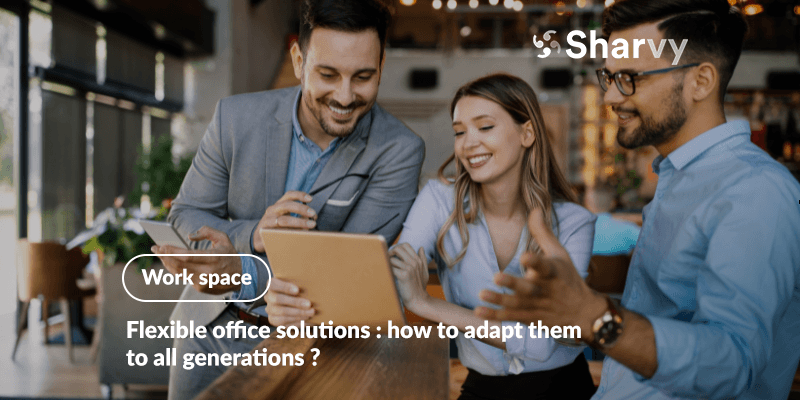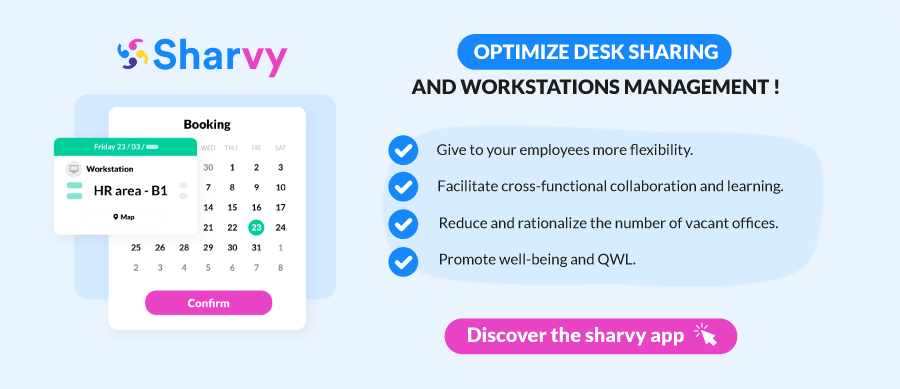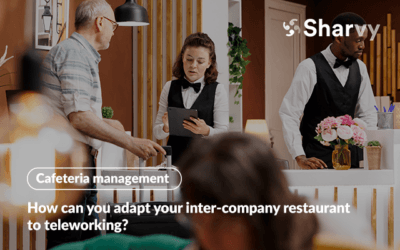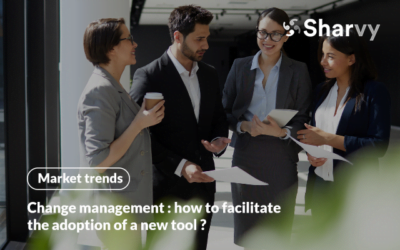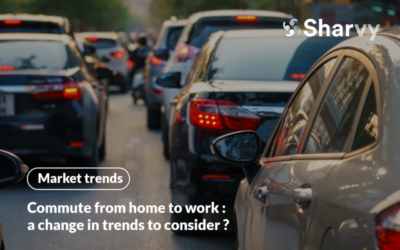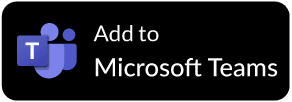What if the traditional office, as we know it, were already obsolete? Flexible office solutions, designed to meet the need for flexibility and optimisation of workspaces, are winning over more and more companies.
But behind this revolution lies a major challenge : how do you get generations with sometimes conflicting expectations, habits, and aspirations to coexist in the same space?
While some employees, attached to their personal offices, struggle to find their bearings in this new layout, others, fervent supporters of mobile working, see it as an opportunity for fulfilment and mobility.
So how can flexible office solutions adapt to individual needs without creating tensions or compromising collective performance? What strategies can companies adopt? Our advice.
Flexible office solutions : a booming model?
Flexible office solutions are based on a simple principle : eliminating dedicated offices to offer greater flexibility. In practical terms, this means that no employee has a fixed desk. When they arrive, they choose the workspace that best suits their needs at the time : a workstation in an open space for exchanging ideas, a quiet space for concentrating, or a meeting room for collaborative work.
The benefits are numerous. It reduces your property costs, encourages collaboration and modernises your employer brand. For your employees, it provides more freedom, improves the Quality of Life & Working Conditions (QWLC) and encourages a more agile way of working.
But… is it really as perfect as it’s made out to be?
In reality, its implementation poses many challenges. The absence of a fixed office can lead to a loss of reference points and a reduced sense of belonging. What’s more, without a dedicated desk, it can be difficult to find colleagues and organise teamwork effectively.
Consequently, the success of the flex office depends on effective digital tools (workstation reservation, collaborative solutions, various equipment). It must therefore be accompanied by a well-orchestrated transition.
Download our White Paper (free of charge) to read our advice!
Different generations’ expectations regarding flexible office solutions.
1. Generation X (1965-1980) : reconciling flexibility and structural reference points.
Often described as a pivotal generation, Generation X has experienced both the rigid structures of traditional offices and the emergence of digital technology. They aspire to a balance between flexibility and structure, which makes them a generation fairly receptive to the flexible office, provided that certain reference points are preserved.
This is why they remain attached to fixed landmarks and a structured organisation.
Thus, the idea of not having a dedicated workstation can be perceived as a constraint, particularly for executives and managers, who need a more personal space to manage strategic responsibilities.
They often appreciate collaborative spaces, which encourage interaction and creativity, but they also feel the need for areas dedicated to concentration and confidentiality.
What’s more, efficiency remains a priority for this generation, which attaches great importance to communication and organisational tools. The use of applications to plan working days, reserve spaces, and ensure smooth interaction with teams is essential to avoid any loss of productivity due to the absence of fixed offices.
So, for this generation, the flexible office solutions should not be synonymous with disorganisation but rather with a flexible working environment that has well-defined reference points.
2. Millennials (1980-1995) : the need for flexibility & stimulating experiences.
This was the first generation to grow up with the Internet. Millennials (also known as Generation Y) are deeply attached to the concepts of flexibility and mobility. For them, work is not defined solely by a physical location, but by the possibility of working wherever and whenever they want. The flexible office solutions therefore meets their expectations, provided that is part of a hybrid model combining face-to-face work and teleworking.
Accustomed to juggling several tools and platforms, they expect their company to provide them with high-performance solutions that allow them to work efficiently, wherever they are. The absence of a dedicated office is generally not a problem for them, as long as they have access to comfortable spaces suited to their tasks.
Well-being at work is also a priority for this generation. Millennials prefer friendly working environments, where ergonomics, decoration and relaxation areas play a key role.
Companies like Google and Airbnb, pioneers in innovative office design with relaxation areas, modern cafeterias and modular zones, are perfect examples of these expectations.
3. Generation Z (1995-2010) : a vision of work based on immediacy and meaning.
Born into an ultra-connected world, they see mobility and flexibility as the norms. For them, the notion of a fixed office seems obsolete, and the flex office is the perfect answer to their need for diversity and spontaneity. They prefer open, modular spaces that allow them to move easily from one project to another, as well as to work collaboratively with different teams.
Their relationship with work is marked by a need for immediacy and constant interaction. They appreciate brainstorming areas, informal zones and tools that encourage rapid collaboration, such as Slack and Microsoft Teams. Far from looking for routine, they want to evolve in a stimulating environment, where exchanges are fluid and innovation is encouraged.
Finally, this generation is particularly attached to corporate values and culture. They are more committed to organisations with a more human approach to management, and to those that share their commitments, particularly in terms of Corporate Social Responsibility (CSR).
So, how do you adapt flexible office solutions to different generations of workers?
1. Use a desk reservation application.
One of the keys to the success of the flex office is the adoption of digital tools.
For generation X & millennials, who are looking for a balance between flexibility & structure, office reservation software is becoming a must-have.
This software makes it possible to choose & reserve a workstation in advance, guaranteeing predictable, as well as efficient, organisation.
Generation Z, in particular, will expect a frictionless experience from these tools, where space reservation is almost instantaneous and fully connected to the applications they already use (Microsoft Teams, for example).
The Sharvy solution meets these expectations by offering, at the same time, a real-time view of the availability of spaces – workstations, rooms, quiet & collaborative areas – while simplifying their allocation. This flexibility allows each generation of workers to choose a workspace according to their preferences, by planning their schedules in advance.
Bear in mind, however, that these reservations should not be seen as a mere convenience. It is essential that the reservation algorithm is fair, to avoid situations where certain employees, for example the oldest (and most influential), benefit from privileged access to the best spaces.
That’s why, before you begin your search for office reservation software, take the time to identify exactly which software works according to a fair algorithm, such as Sharvy.
2. Set up different spaces : different zones (silence, collaboration, relaxation).
By its very nature, the flex office offers a unique opportunity to break down the barriers between teams and encourage impromptu meetings between your employees. So, to make the most of this advantage, the layout of your spaces must not only meet the specific expectations of each generation, but also break down silos.
Generation X, keen to reconcile freedom with established points of reference, is looking for a working environment with distinct zones: concentration areas for working in peace & clearly delineated collaborative areas for team exchanges.
Millennials, who are adept at hybrid working, are looking for modular spaces that encourage both creativity and well-being, with relaxation zones where they can recharge their batteries.
Lastly, generation Z, in search of spontaneity and innovation, prefers open, interactive spaces, incorporating digital tools to facilitate teamwork, while at the same time having access to occasional bubbles of concentration.
To reconcile these different expectations, it is essential to adopt a hybrid and adaptable layout, offering everyone the possibility of choosing their working environment according to their needs. This is where space reservation, via applications such as Sharvy, comes into its own. These solutions can even include the option of reserving time slots.
3. Choose an application with a random workstation allocation algorithm.
Using a dedicated application, such as Sharvy, your employees can choose their preferences for the workstation they will occupy for the day (dual screen, open space, dedicated area : sales, development, marketing, etc).
However, once these details have been recorded, the application’s algorithm assigns the workstations randomly.
This kind of algorithm encourages employees of different generations to mix, breaking down silo habits and encouraging informal encounters. This mix improves inter-departmental communication and encourages innovation through unexpected interactions.
In concrete terms, the algorithm takes into account various parameters such as the availability of workstations, the preferences declared by your employees, the days they are present, and specific needs (quiet areas, collaborative spaces, proximity to certain departments).
Each week, and according to the rules defined by the company, the desks are allocated randomly, but with adjustable criteria to guarantee a smooth & adapted experience. For example, an employee who needs to concentrate may be given priority in a quiet area, while a project manager may be placed closer to his team depending on the needs of the moment.
This random allocation prevents certain employees from always appropriating the « best » offices, thus avoiding conflicts and inequalities of access to workspaces in a flex office organisation. Every employee benefits from the same opportunities, which promotes a fairer working environment.
4. Co-construct your teleworking policy with your employees.
Flex office and teleworking are often inextricably linked.
So define clear rules, taking into account the needs and expectations of each generation, as well as those of managers: how many days a week should employees telework? Should they be fixed or flexible? Should there be exceptions?
Once these parameters have been established, organise a coherent rotation between teleworking and physical presence. Find the right balance between employees who are completely averse to teleworking, and on the other hand those who want to do it more than two days a week. It’s up to you to define the rota calendar.
Finally, formalise the flex office & teleworking framework by drawing up a charter. This should be communicated to and signed by all your employees.
Don’t forget to include good flex office practice: freeing up, tidying up and cleaning your office at the end of the day, so that it can be used by someone else the next day.
5. Tailor the changeover to a flex office to each generation.
Adopting the flex office is not just a question of physical layout & digital tools. It also requires change management support to help each generation adapt to this new way of working.
For Generation X, who are often more attached to traditional working practices, it is essential to offer training in digital tools (office booking applications, collaborative solutions, etc.) and to explain clearly the benefits of the flex office, particularly in terms of collaboration and efficiency. This helps to reduce the anxiety associated with the disappearance of the fixed office.
Millennials, who are more familiar with digital & hybrid working, will appreciate workshops & webinars focusing on optimising well-being & productivity in a flexible environment.
Generation Z, already accustomed to digital and flexible working environments, will benefit above all from awareness-raising sessions on instant collaboration and the importance of a stimulating workspace. In short, personalised support for each generation is essential to ensure the successful implementation of the flex office.
In conclusion
There’s no doubt about it : flexible office solutions disrupt habits and can’t suit all your employees from the outset.
Like any major change, it will meet with resistance before it is accepted. Each generation reacts differently: some see it as an opportunity, while others see it as an upheaval of their reference points. Then, gradually, a constructive dynamic is established, geared towards new ways of working.
The important thing is to support this transition by involving your employees from the outset, taking account of their expectations and fears. By encouraging them to listen and adapt, you can (really) transform this change into a lever for performance and well-being at work.
Have a question? Check out the following FAQ !
To ensure the success of flexible office solutions, which indicators should be monitored?
There are several indicators to monitor. Firstly, accurately assess the average occupancy rate of your workspaces. Take stock of the number of employees & anticipate any growth in headcount.
Also take into account your peak and off-peak periods. Observe trends & determine a consistent flex office rate.
Employee satisfaction is another crucial indicator, which can be measured by regular surveys and interviews. This allows you to check whether they feel productive and comfortable in a flex office working environment. The rate at which offices are booked can also reveal whether certain spaces are better suited to the needs of your teams than others.
What challenges does the flexible office solutions pose to more experienced generations?
It may be more difficult for Generation Xers, who are used to fixed workstations and structured organisation, to adapt to the flexibility of flexible office solutions.
The absence of a dedicated desk can be perceived as a lack of reference points and anchoring, which disrupts their comfort and efficiency. What’s more, managing digital tools such as office booking platforms and collaborative tools can be a hindrance for those less comfortable with technology.
This can lead to feelings of discomfort. For this reason, and to ease their transition, it is important to provide them with personalised support, practical training in digital tools, and explanations of the benefits of the flexible office solutions, as mentioned above.
Want to find out more? Check out our latest articles!
How can your inter-company restaurant adapt to teleworking?
Teleworking : how can you manage the number of people using your inter-company restaurant & adapt your offer to new working habits? Focus.
Change management : how to facilitate the adoption of a new tool?
What are the essential steps to facilitate change management in your company ? Our advice and best practices can be found here.
Commute from home to work : a change in trends to consider ?
Commute from home to work : what trends can be observed? What are the risks? How can they be improved? Focus in this article.
Subscribe to our newsletter!
PARKING & WORKPLACE MANAGEMENT SOLUTION
Car park management - Charging points monitoring - Desk booking - Booking by time slots
SUBSCRIBE TO THE NEWSLETTER
Receive the latest Parking & Workplace trends by email once a month.

